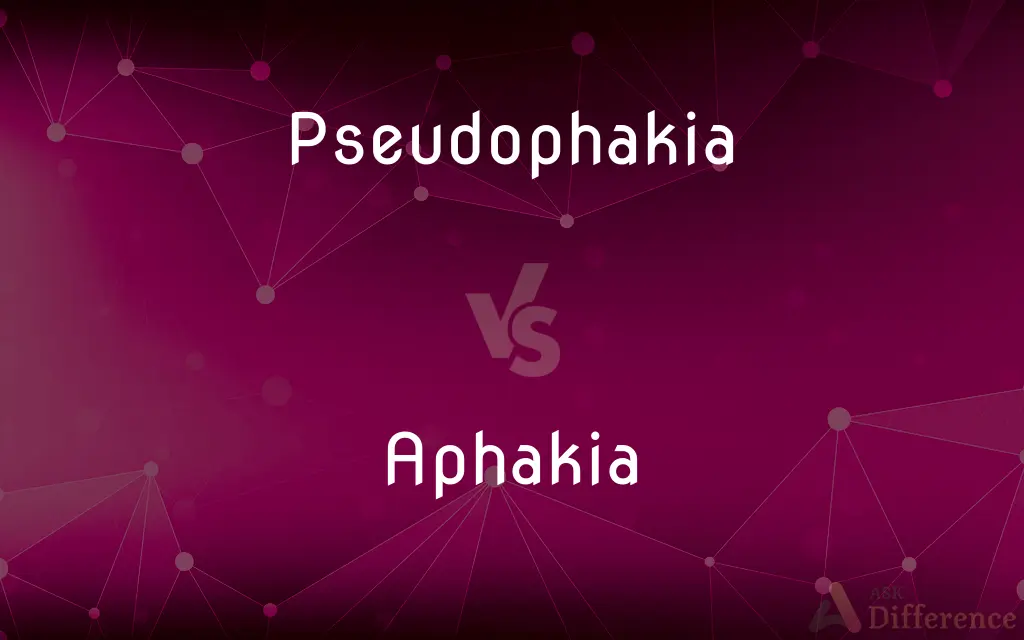Pseudophakia vs. Aphakia — What's the Difference?
By Tayyaba Rehman & Urooj Arif — Updated on April 1, 2024
Pseudophakia refers to the condition of having an artificial lens implanted in the eye, typically after cataract surgery, whereas aphakia denotes the absence of the lens in the eye, which may be due to surgical removal, injury, or congenital factors.

Difference Between Pseudophakia and Aphakia
Table of Contents
ADVERTISEMENT
Key Differences
Pseudophakia is a term used when an artificial intraocular lens (IOL) replaces the eye's natural lens, which has been removed due to cataracts or other eye conditions. This surgical intervention restores vision by implanting a synthetic lens, allowing light to be properly focused onto the retina. The presence of an IOL provides a permanent solution to correct vision affected by the removed natural lens. Aphakia, on the other hand, describes a state where the eye's natural lens is missing without replacement. This condition can result from surgical removal during cataract surgery if an artificial lens is not implanted, or due to other reasons such as injury or congenital absence. The lack of a lens means that light entering the eye is not focused correctly, leading to significantly impaired vision. Individuals with aphakia may require corrective measures, such as wearing eyeglasses or contact lenses with high magnification, to help focus light onto the retina.
While pseudophakia essentially represents a corrective state following the intervention to address issues like cataracts, aphakia highlights a deficiency or absence, necessitating alternative methods to achieve visual clarity. The transition from aphakia to pseudophakia through the implantation of an IOL marks a significant advancement in the management and rehabilitation of patients with lens-related vision problems.
The distinction between the two conditions lies in the presence or absence of a lens within the eye and the subsequent approaches to managing vision correction. Pseudophakic individuals typically experience a restoration of vision post-surgery, thanks to the artificial lens. In contrast, aphakic individuals, in the absence of corrective devices, face challenges in vision clarity due to the unaided eye's inability to properly focus light.
In terms of treatment and management, the approach for pseudophakic patients mainly revolves around the adjustment to and care of the implanted lens. For aphakic patients, the focus is on selecting the most suitable form of vision correction, which could include eyeglasses, contact lenses, or considering the possibility of an artificial lens implantation at a later stage.
Understanding these conditions is crucial in the field of ophthalmology, not only for the surgical treatment of lens-related issues but also for the ongoing care and lifestyle adjustments required by patients post-treatment. The evolution from aphakia to pseudophakia through surgical advancements has greatly enhanced the quality of life for many individuals by restoring or significantly improving vision.
ADVERTISEMENT
Comparison Chart
Definition
The presence of an artificial lens in the eye.
The absence of the natural lens in the eye.
Cause
Replacement of the eye’s lens with an IOL during surgery.
Removal of the lens due to surgery, injury, or congenital reasons, without replacement.
Vision Correction
Vision is corrected through the implanted IOL.
Requires external vision correction like eyeglasses or contact lenses.
Treatment
Involves the surgical implantation of an IOL.
Management includes using corrective lenses or considering IOL implantation.
Outcome
Restores or improves vision post-surgery.
Significantly impaired vision without corrective measures.
Compare with Definitions
Pseudophakia
Condition of having an artificial lens implanted in the eye.
After cataract surgery, the patient achieved clear vision through pseudophakia.
Aphakia
The absence of the lens in the eye.
Aphakia can result from surgical lens removal without replacement.
Pseudophakia
Provides a permanent vision correction option.
Pseudophakia has become a common outcome of successful cataract surgery.
Aphakia
Can be congenital or acquired.
Congenital aphakia is rare but requires early intervention for visual development.
Pseudophakia
The replacement of the natural lens with a synthetic one.
Modern ophthalmology offers pseudophakia as a solution for cataract-affected eyes.
Aphakia
Requires high magnification in corrective lenses.
Aphakic patients often use specially designed glasses or contacts to see clearly.
Pseudophakia
Involves implanting an intraocular lens (IOL).
Pseudophakic patients often report significant improvement in vision quality.
Aphakia
Leads to uncorrected vision impairment.
Without corrective lenses, aphakia causes blurred vision and depth perception issues.
Pseudophakia
The state after cataract removal and lens implantation.
Pseudophakia requires monitoring to ensure the IOL remains effective and properly positioned.
Aphakia
The condition before artificial lens implantation.
Before opting for pseudophakia, individuals with aphakia may explore various corrective options.
Pseudophakia
The substitution of the natural crystalline lens of the eye with a synthetic lens
Aphakia
Aphakia is the absence of the lens of the eye, due to surgical removal, such as in cataract surgery, a perforating wound or ulcer, or congenital anomaly. It causes a loss of accommodation, high degree of farsightedness (hyperopia), and a deep anterior chamber.
Aphakia
(ophthalmology) The absence of the lens of the eye, causing hypermetropia and a loss of accommodation.
Aphakia
An anomalous state of refraction caused by the absence of the crystalline lens, as after operations for cataract. The remedy is the use of powerful convex lenses.
Aphakia
Absence of the natural lens of the eye (usually resulting from the removal of cataracts)
Common Curiosities
What are the vision correction options for aphakia?
Options include wearing high magnification eyeglasses or contact lenses, and in some cases, surgical implantation of an artificial lens.
How is vision affected in aphakia?
In aphakia, the absence of the lens prevents proper focusing of light on the retina, leading to significantly impaired vision without correction.
Is there a risk of vision loss with pseudophakia?
While complications are rare, ongoing monitoring is essential to address any issues such as IOL displacement or post-surgical infections promptly.
Are there activities that pseudophakic or aphakic patients should avoid?
Patients are generally advised to avoid activities that could risk eye injury, especially soon after surgery, but specific recommendations can vary.
How do patients adapt to life with an IOL after cataract surgery?
Most adapt well, experiencing restored or significantly improved vision, although it may involve some period of adjustment to the IOL.
What considerations are important when choosing an IOL?
Factors include the material, design of the lens, the patient's lifestyle, and specific visual needs.
Can aphakia be treated with surgery?
Yes, aphakia can be treated by implanting an artificial lens, converting the condition to pseudophakia and restoring vision.
What leads to the condition of pseudophakia?
Pseudophakia occurs after the surgical replacement of the eye's natural lens with an artificial intraocular lens, commonly due to cataracts.
How does pseudophakia improve quality of life?
By restoring clear vision, it enables individuals to resume daily activities and significantly enhances their overall quality of life.
Can children be affected by aphakia?
Yes, children can be born with aphakia (congenital) or acquire it through injury or surgery, necessitating early intervention for visual development.
How has the treatment of aphakia changed over time?
Advances in surgical techniques and IOL technology have made pseudophakia a more accessible and effective treatment option, significantly improving outcomes for aphakic patients.
Can aphakia and pseudophakia affect both eyes?
Yes, both conditions can affect one or both eyes, depending on the underlying cause and treatment approach.
What role do eye doctors play in the management of these conditions?
Ophthalmologists play a crucial role in diagnosing, treating, and managing aphakia and pseudophakia, including performing surgery and prescribing corrective lenses.
How is the success of pseudophakia measured?
Success is typically measured by the improvement in visual acuity, patient satisfaction, and the absence of or minimal post-operative complications.
What future advancements might impact the treatment of aphakia and pseudophakia?
Ongoing research into lens materials, design, and surgical techniques promises to further improve outcomes and patient experiences with these conditions.
Share Your Discovery

Previous Comparison
Buck vs. Antelope
Next Comparison
Esker vs. MoraineAuthor Spotlight
Written by
Tayyaba RehmanTayyaba Rehman is a distinguished writer, currently serving as a primary contributor to askdifference.com. As a researcher in semantics and etymology, Tayyaba's passion for the complexity of languages and their distinctions has found a perfect home on the platform. Tayyaba delves into the intricacies of language, distinguishing between commonly confused words and phrases, thereby providing clarity for readers worldwide.
Co-written by
Urooj ArifUrooj is a skilled content writer at Ask Difference, known for her exceptional ability to simplify complex topics into engaging and informative content. With a passion for research and a flair for clear, concise writing, she consistently delivers articles that resonate with our diverse audience.














































